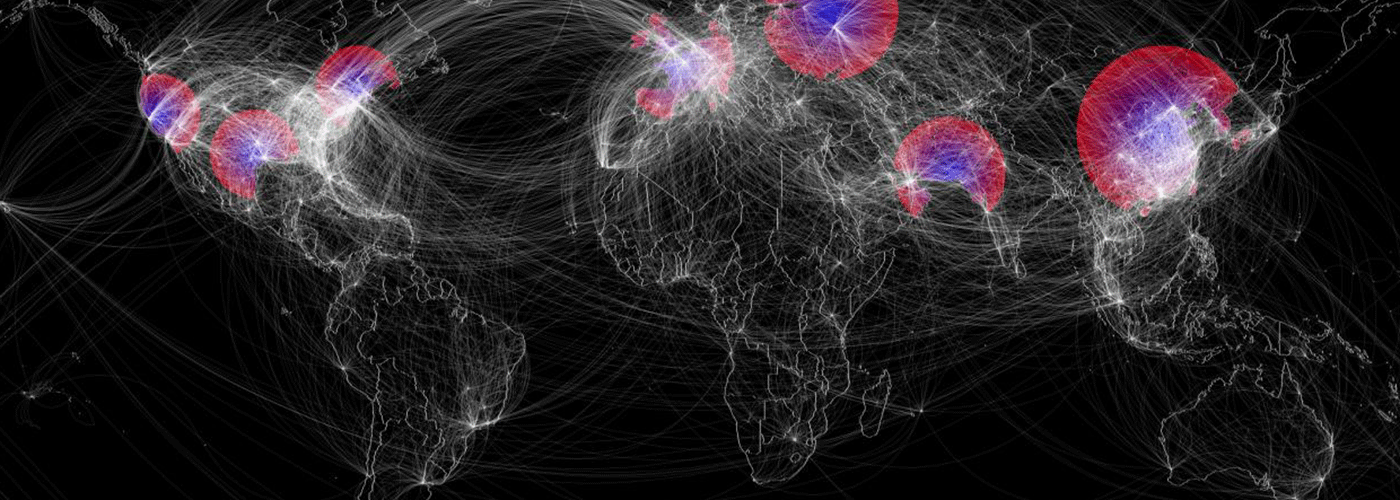by Vittorio Bollo
“While we don’t know when or where the next pandemic will occur, we know one is coming.” So said Rebecca Martin, director of the Center for Global Health at the Centers for Disease Control and Prevention (CDC), back in July 2018. Those were prescient words by Martin: It was a mere 18 months later when the COVID-19 pandemic swept the entire world.
Coronavirus arguably shook up the world like no pandemic since the Spanish Flu of 1918. After all, who of us were ever in near-global lock-down because of a virus before this? Ed Young even called COVD-19 “a truly modern epidemic” in The Atlantic in February 2020.
But are we actually living in an ‘age of epidemics’? Is there any evidence that there has been a surge in global or near-global epidemics in recent years? And if so, why?
Is This An Age of Epidemics?
In short, the answer appears to be yes, this is an age of epidemics. Consider that the Geneva-based World Health Organization (WHO) declared COVID-19 a “public-health emergency of international concern” (PHEIC) on January 30th, 2020. It is a designation that the WHO has used five times before: for H1N1 swine flu, polio, Zika, and twice for Ebola.
What’s telling is that COVID-19 is the sixth such designation by the WHO in just over a decade. No other like period in the last 100 years has had so many epidemics on a potentially global scale. And that’s not to mention outbreaks in the last 20 years of serious diseases including Severe Acute Respiratory Syndrome (SARS), Middle East respiratory syndrome (MERS), Zika virus, Nipah virus, yellow fever, and Lassa fever.
There of course have been pandemics with devastating losses of life throughout human history, many of them in ancient times. These ranged from the Plague of Athens in 430 B.C. that killed 100,000 people, to the Antonine Plague that ravaged the Roman Empire and killed over 5-million people from 165-180A.D. There was the bubonic plague or Black Death that is thought to have killed half of Europe’s population from 1346 to 1353. And of course the Spanish Flu that killed up to 100 million people worldwide from 1918-20.
Nevertheless, WHO-designated PHEICs do seem to be on the increase. There must be reasons for this. Why is our current era so conducive to epidemics? What factors have made this an age of epidemics?
Modern Factors for Epidemics
There are a number of factors that seem to be enabling the rising incidence of pandemics with global potential. Each one of these factors is ‘uniquely modern’ in that they are a mirror to the contemporary state of human society, including our relationship with the natural environment.
Burgeoning Populations
The world’s population continues to grow at a rapid rate. It’s logical that as the world’s population expands, so the number of those who can get infected will grow too. The World Economic Forum (WEF) in March 2020 quoted a study that stated: “The number of outbreaks, like the number of emerging infectious diseases, appears to be increasing with time in the human population both in total number and richness of causal diseases”.
Urbanization won’t help either. Today, roughly 55% of the world’s population lives in urban areas. That percentage is projected to increase to 68% by 2050, according to the UN’s Department of Social and Economic Affairs. A significant portion of this high-density living will be in impoverished neighborhoods, often with people living in extremely close quarters and in unhygienic conditions. These urban factors will greatly promote the spread of infectious diseases.
Travel, Travel, Travel
Humans have never criss-crossed the planet as much as they do today, whether for business or leisure. According to the World Bank, there were 4.2 billion passenger journeys by air in 2018, compared to 310 million journeys in 1970. The International Air Transport Association (IATA) forecast that this would almost double to 8.2 billion airplane journeys by 2037. That’s a lot of mobility on a global scale – a perfect conduit by which any pathogen can spread.
There has also been a huge increase in those floating petri dishes known as cruise ships. The cruise industry was until 2017 the fastest-growing sector in the leisure travel industry, with annual growths of nearly 7% and a 62% increase in passengers between 2005 and 2015.
Climate Change
For years now, scientists have predicted that one of the impacts resulting from climate change will be an increase in infectious diseases and global pandemics, as reported by the WHO and Columbia University, among many others. Changing climate should result in the spread of vectors such as mosquitoes. The Zika virus that suddenly emerged in 2015 was able to spread from Brazil to the rest of South due to the El Niño effect, itself exacerbated in recent times by climate change, according to climatologists.
Environmental Devastation
There is no denying that the natural environment is under siege worldwide. Deforestation and loss of species and biodiversity are increasingly rapidly, examples of what the United Nations declared as being the “unprecedented” decline of nature in 2019. This assault on the natural environment has health-related repercussions.
For example, National Geographic wrote in November 2019 that there is a direct correlation between deforestation and the spread of infectious diseases. The National Geographic article cited the first outbreak of deadly Nipah virus in 1997 caused by displaced bats due to jungle clearings for agriculture in Indonesia. Research by the EcoHealth Alliance showed that 31% of outbreaks of new and emerging diseases were directly linked to deforestation.
It’s not that the viruses and other pathogens are ‘new’ – rather, it’s that we are now in ever-greater contact with them due to environmental factors. As Dr. Mike Ryan, the assistant director-general for emergency preparedness and response at the WHO, told the Huffington Post in 2018: “What’s shifting and changing is not the bugs ― it’s the humans. What’s changed is our relationship with those viruses, our relationship with the rainforests.”
More Disease, Greater Probabilities
Not only are we living in an era of more epidemics, but we’re also living in an era of more outbreaks of disease that have the potential to become global pandemics. An international benchmark is the WHO’s Blueprint priority diseases list that contains eight categories of disease, any one of which has the potential to spread globally and cause widespread mortality and economic upheaval. The more outbreaks of the listed diseases, the greater the risk for an eventual global pandemic.
This reality was revealed in June 2018, when it was reported that, for the first time ever, the world was having to contend with six of the eight categories listed in the WHO’s Blueprint. The ‘Deadly Six’ were ebola, Lassa, Nipah, MERS, Rift Valley fever, and Zika, all of which were active outbreaks during that month of 2018. The only two WHO-designated diseases ‘missing’ as outbreaks in June 2018 were Crimean-Congo haemorrhagic fever (CCHF) and, very ominously, the one designated by the WHO as ‘Disease X’.
Fair to say that COVID-19 is that ‘Disease X’?
Final Thoughts
Bill Gates says we should prepare for a deadly outbreak as we do for war. He makes a very valid point. The potential devastation to human life and to the economy that a pandemic can cause is certainly akin to that of being at war.
Unfortunately, the response to the COVID-19 pandemic has been, for the most part, haphazard, confused, and inefficient. The world needs to be better prepared for the next one, which is surely just down the road.
It should be cautioned that what we have experienced with COVID-19 is not unique in human history in terms of morbidity rates; after all, the Athens and Antonine plagues had huge infection rates at a time when populations were far smaller than today.
Even COVID-19’s global scale isn’t novel, as seen with the Spanish Flu a century ago. There was a lot less mobility in the 14th century than there is today, yet the Black Death wiped out half of Europe in just a few years.
But perhaps we do well to heed the fact that this is the sixth WHO-designated PHEIC since 2004. Perhaps there’s something to the opinion that this a truly modern epidemic. Only when we acknowledge the modernity of how we spread disease can we then put in place the measures needed to ensure more effective, rapid responses to epidemics now and in the future.










Add comment